October 31, 2004
Cool Stuff
I was looking for Craig's List, Barcelona (no dice) and I found this little hideaway for earnestly fevered writing:
5) Very oddly, six DIFFERENT individuals thought that I was a middle-aged black man, and based upon that assumption, chastised me harsh harsh harshly for openly and casually setting such a bad example for black young men who as it is "only have violent black males as role models." (Yes, Don P., hang your head in shame, you actually wrote that.) And five other quotes to that effect. I am a bad black male role model. I need to take a good long look in the mirror and ask myself how funny my little antics really are. Young men read that kind of ad and think that knife fighting is this fun and silly thing that can be traded for muffins. Bad dog. No biscuit.
* To this I respond: I am a white 22-year-old female. I do not understand how the exact characteristics of middle-aged, black and male where communicated through my ad, and after reading over it again, I will go out on that there limb and postulate that there were NO indications of any of these characteristics AT ALL and there are six individuals out there with some pretty serious projection problems. That?s right ? after deliberation I have come to the conclusion that IT?S NOT ME, IT?S YOU.
Wierd, personal, interesting writing here. I don't know what's going on at all. Investigating. A labyrinth.
(It might seem racy to the timid and young souls out there, so don't click on unless you're mature.)
October 30, 2004
Octubre

Ever since Juno passed away, a cascade of decisions and circumstances have led us into finally begin furnishing our place as winter approaches. We've put this off for a long time, living with remnants and cardboard boxes. It's been great, minimal stylin'. Now, as the colder weather is coming and we are apprehensive... probably overestimating what is to come as we did the coming summer heat whilst living in Texas.
As you might have seen in the last post about the kitchen, all of a sudden, a gestalt... now, there's a place for everything. The way we think about improving this place now has a sense of a destination for what "home" might mean here physically at #6 Sant Telm.
Excellente.
Since the last binge of painting, the revenge of household chores and projects had their way. Our topside terrace is complete: walls painted white, rail installed and painted black, doors and side lites replaced, stained and sealed, the walls cleaned up... it's not a tv room or a guest bedroom, or a library, we left it minimal, a room in the abstract, Marfa stylin'.
D. Judd profilin'.
(...sort of.)
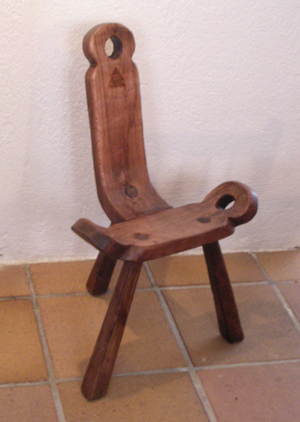
Meanwhile, our German neighbors are selling some of their furniture. The photo at the top of this blogpost features our new table, Catalan circa 1920's or so. A retired couple (hydrologists), they were victims of a "friend" who sold their home whilst they were away in Saudi Arabia on a contract job. I don't know how this could have happened, but it did. Their case has been languishing in the courts here for six years so far. Now, all they have is a pension and a possible redemption in the courts. They live in a small apartment in Tossa until the justice system comes to a conclusion. I try to keep the conversation positive, naturally. A "New-Now" for them, indeed.
Our friends Piet and Monique are off for a long vacation and they asked us to watch thier dogs, splitting the responsibility with thier niece here in Tossa. We also got to drive their car, a silver Land Rover commuter variety. Diesel. It is amazing to be able to extend your range after you've been on foot for so long.
After Spanish class, we drove to Girona to plunder the super stores clustered there. We found all the stores closed for a festival, so we steered toward another complex in Badalona instead. Folks, I have to report that there is not a whit of difference in the shopping experience between the USA and Spain. I don't know for sure, but I suspect that this is the case for the EU in general. All over the world, we are building Car Cities. There is no alternative urban idea to compete with the pattern of suburbanization, the zoned city.
EU/Spain/Catalonia----- USA/ SOCAL
Decathalon----- Sports Chalet
Bauhaus----- Home depot
Media Market----- Circuit City
It took the entire day, we were exhausted. We haven't been grinding the gears of consumption since we arrived here in Tossa. No TV, no car... and it's all good. We like finding the day to day rythmn without prothesis. But this day, it came rushing back in. Alotta consumin' goin' on here. A door mat, a rug, a lamp, mittens, sweaters, and more. Civilized. We stopped in Lloret to eat at a Mexican restaurant that we heard of in class. Not so good. A true Cali-Mex menu would kick ass here. This place was Catalan-Mex... and I guess it had to be.
Returning home, we stash our stuff, park the car and visit Kiko and Teresa. They had some furniture that they are replacing and they offered the old ones to us... thanks but no thanks (sometimes this can be good, but not this time. We repair to El Pirata for beers and rounds of Parcheesi. The games go on until four in the morning. We bailed at three.
That night, we met another friend of El Pirata, a painter from Barcelona, Enrique Bertrand. I was introduced as an abstract painter. An older guy (maybe he's in his late 60's), he told me he was of the old school, las Bellas Artes. He said that in his world, one only begins to paint after years of drawing. Immediately I wondered how good his hand was. Then, I thought about the regime it must be to draw so much, how a mind can be formatted by the experience. For me, even from painting to painting, an exceptional experience such as a particularly good painting, can be a hurtful impediment for the one that comes after. All the better to shatter it for the next.
I thought too, how intimidated a person would feel if they entered art around the wall of drawing excellence. My early days were saturated with drawing. I visited the Prado when I was thirteen and I was steeped in drawing for years before that seminal moment. I haven't drawn like that for a while. I think David Hockney is admirable for his restless pencil. My skills are no doubt rusty but if I had a chance to oil them down, it'd be a kickin' engine. (Temerity, an occupational hazard.)
He thought that color was the pentultimate problem, nearly impossible to negotiate at all. All the better to tackle it, I said. Easy things can be fun, but it's the things that bedevil us that spins the story worth writing.
Cool guy, a big mane of hair swept back. Leather jacket, I could see the longjohns and that he knows the cold here. Old Catalan. He makes his money painting portraits and spending them on wine, women and song. Ladies man, you can tell. Well, I'm not sure about the song. The ladies (Stephanie, Monica, & Pepa) swept him into a game of Parcheesi.
Bertrand was delighted.
They played loudly with intense focus (great language immersion training). They played, and the owner of the bar, Joan, ferried paintings down from his apartment home upstairs (above the bar) for our/my appreciation: impressionist sailing impastos, surrealist landscapes, slap happy abstractions... collected with an innocent but interested eye. And in each painting, there was something redeemable, something worth remembering later. A good collection.
A good night.
October 23, 2004
A New Kitchen

Our place used to be a restaurant here in Tossa... and before that a ye olde fisherman's bar and before that, a winery, a Cava. When we bought it, we gutted it completely, only saving a few pieces of furniture. The kitchen was outside in a separate building... now, we call it our "garage".
Our kitchen now is in where the bar used to be. When Kiko demo'ed the place, he slapped in a sink and roughed in a hot water line (only hot water, no cold). We bought a small refrigerator (by USA standards), a toaster oven and a hot plate. That's our kitchen! And we like it. We cook great meals and we are enjoying every little change, improving this poco a poco, as much from neccessity ($) as from the simple pleasure of doing it slowly.
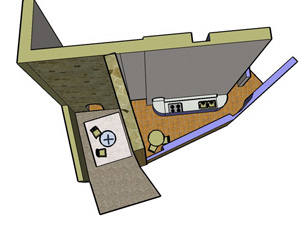
After much deliberation, we think we have hit upon the best way to build in a kitchen into our house. Here are a few drawings, hammered out in my very own first ever CAD program:
BLOGPOST IN PROGRESS
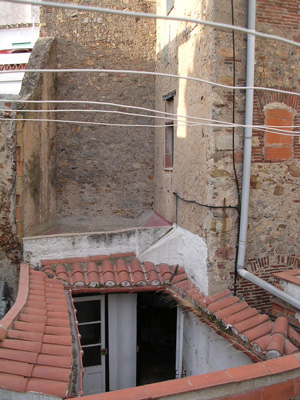
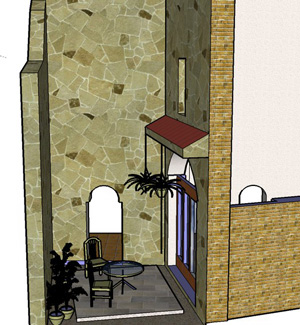
The previous owner had cobbled additional space onto the building to provide a bar, apparently. It is such a ramshakle job, none of it is appealing. We had a funky strange cone shaped space that was left over. We previously thought it could be a dining room. But we already had a fine location for a dining room in its present location.
After much time wrangling with the thought of how to deal with it... it hit us: why not take it all down? Oh yea, and it will be soooo fun to demolish the encrustations that mar this ancient bodega.
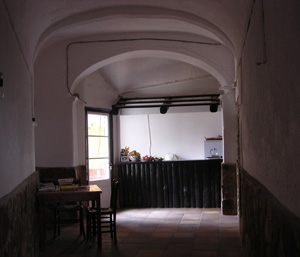

And the bonus: we get alotta light. Daylight will be able to get into the cold interior. All that stone is chilly.
And we get a huge door set into the arch with a top lite that can open up to vent air out the top.
Perspectival tricks make the walls of the room parallel, but they angle in like a funnel. Funky.
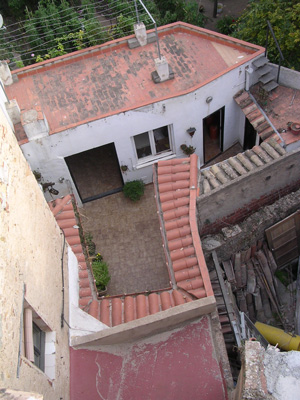
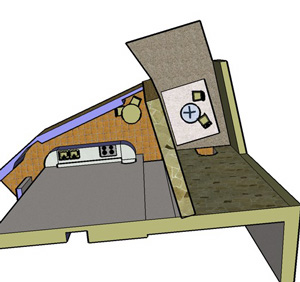
You can see the old kitchen- now a "garage" in the building at the top of the foto. All the stuff down below gets to get torn away, clay tiles, parapets, roofs...
And the kitchen has a galley plan, one long counter. We'll tuck a pantry into the space below the stairs. The refrigerator can fit in there too. There's not much more room for anything else. But that's ok. Now the house seems to fit us finally.
It's going to be fun. Next year or so.
Glug, Glug...

"Glug, Glug..."
Michael Reafsnyder is getting ready for a show at Marta Cevera's Gallery in Madrid and he was kind enough to share the jpegs with me and hence, you. Michael and I are in the "meaty treat" territory of painting and I thought I'd share a few thoughts and the back and forth email conversation we had about them (with Michael's kindly permission) ... and a stray thought about John Pomara that arose as I was perusing Tom Moody's blog recently.
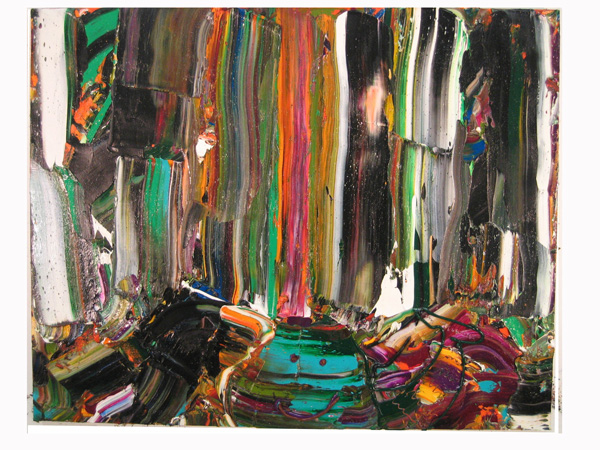
"Flying"
I bagan with something like this:
Is there a narrative of progression here or am I projecting? The happy face is becoming a project of drawing over "facts on the ground". I like this description of the non-objective, or of an abstraction as that which does less to act as a sign. (Yea, the "doing" is our doing, not the painting... but even so.) And there in your paintings is a sea of facts into which is scribed a primitive sign, perhaps for happiness, perhaps to signal affirmation (as if the slathering joy doesn't), perhaps for the innocence of childhood.
Michael has children and a happy family, G-d bless him.
And this project is building on the manners of childhood implied by the happy face. You are drawing past the sign of the happy face as if it were the alpha proceeding towards the omega of a larger vocabulary to come. A fish complete with scales and tail. You could take this all the way up the ladder, octopuses, horses, flowers... as your kids grow, so can your vocabulary.
Parallel projects in overlay. That was my strategy coming out of the gate after grad school, a sandwich of underpainting and overpainting... then, I would paint any which way that took my fancy. I would then finish with a stencil (a drawing after all, like yours) of what started out as letterforms that turned away from the sign. Eventually, I merged the two layers and blended them together.
This was a question, in fact. I was clumsily trying to ask: Michael, do you think of your work as two separable aspects, drawing and painting?
It made me think of drawing and painting, how drawing is a pulling that makes distinctions between one thing and another... and how painting is a smoodge and smudge and control of blending that is inevitable due to the liquidity of paint. An ooze that prompts efforts to control and a distinction (the proverbial line in the sand) that seeks the innocence of childhood and whatever good values we associate with it (play, joy, directness...). If these two layers are vectors on different trajectories, then they will bear on each other more strongly but what if they are converging? Maybe my earlier project is not comparable.
This is where I left it, but here is where I was trying to go:
Certainly the lines are squirts of paint, controlled extrusions, from the fabric of the splash of oozing colors. Is it possible that what I see as drawing is like one of those movie blob monsters who pauses in mid rampage to scribe a primitive hello on it's belly? No, really.. is this a painterly form of television "snow" (actually, the ambient background signature of the big bang) with fleeting images of television shows such as that an alien civilization might see? (Don't sigh.) Is the distinction of sign versus substance present in your work? Is the hedonistic frenzy taking a pause to give a thumbs up to the viewer?
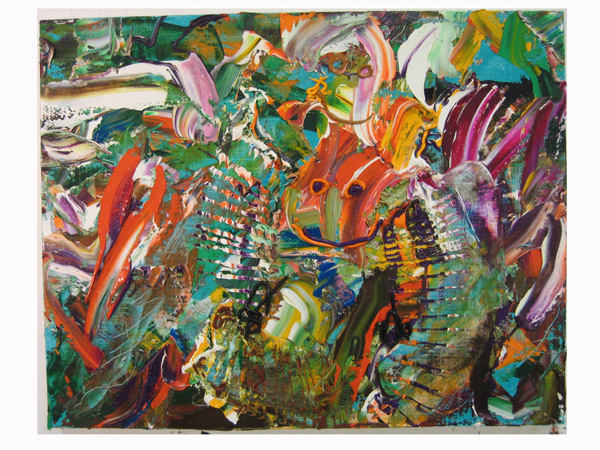
"Me, My, Mermaid"
Michael wrote back:
I have been working on the mermaids trying to get them right and I think this is the first couple of paintings where it happens. The question of how to inscribe drawing on top of, rather than under, the ground of a painting is one of the simple pleasures and tasks that I think painting affords.
He's flipping the convention of paintings as painted-drawings. One might think the simple pleasure is the in the slather, but it's possible that it is the schema of historical process (and perhaps more than history: the intrinsic neccessity that rendering in paint requires) that is messed with plastically.
I often love the bleed of the linseed from oil pain on unprimed paper. It is a ground coming directly from a drawn (squeezed) mark.
Whoa. Drawing = squeezing. Hmmmm.
Keeping narrative out with the mermaid has been a challenge as well as locating her. She became too drawn, too static. How do you allow this creature to glide and float in and out of space and intermingle her with the relic of the smile.
This reminds me of Louis Kahn's use of "Ask what the brick wants to be... it will say that it wants to be in compression.". The tool here is projection, a form of empathy. In both cases, the inquiry is into the nature of materials. With Michael's work, I imagine that there is a theatre in which "glide", "float" and "intermingle" is a metaphor for liquid paint dynamics.
Maybe.
I think this is the push/pull (Hoffman speak) in this new group. Movement, speed, depth, penetration. I could continue movement across the picture plane with the smile, it becomes something else with the mermaid.
I substituted architecture undergrad for art undergrad school. I missed out on the arterial injection of Hoffman.
As for continuing the "growth" vocabulary" this is a great observation. In fact, I paid Isabel 1$ for 10 ideas of things to paint yesterday.
Hey! How can I get into this action? Let's see, if I come up with half a million ideas, I can clear fifty thou a year....
But I don't know if I can be as discerning as his daughter:
What was nice was that Sponge Bob, and other cartoon characters where not listed. I love Sponge Bob, but, that gets into a different territory than mermaids, princesses, and other nice things.
*********************
So I was tooling around in Tom Moody's web blog and I came across John Pomara's work.
Tom hails from Dallas, as John does and Texas has a major relationship with New York, where Tom now lives. Tom's blog is pretty cool, check out his take on the "New Dumb Little Painting", for example.
John is Dallas. He teaches at the local university and his work is championed among few others in the local world class museums in the city. John also gets out of the totality that is Texas. By this, I mean that it is possible to enjoy a full art career life in -and only in Texas.
Texas has everything in great supply: cities with cheap rent for artists to habitate, museums the equal of anything in the world, galleries of all ranks and collectors who focus in depth for an artist's lifetime production. Sometimes I think of Texas as a great inland lake like Lake Nicaragua. In such a lake, there are all forms of sea life now adapted to lake water: fresh water sharks, etc. etc. Some of the fish there see no need to go out to the ocean.
Texas is changing. There are galleries that act as canals to link the great inland sea with oceans beyond (working internationally, art fairs, etc.). Some Texan emmissaries are ranging farther afield. John is one of them.
Tom saw fit to recall John's young work:
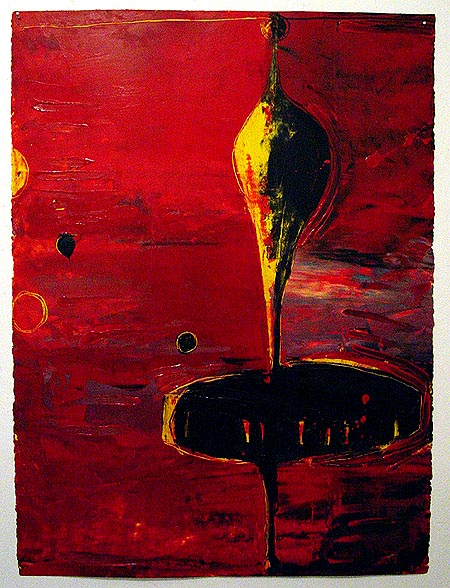
Those were John's hip boot days of painting. I'm thinking of the vector towards Michael's thickness, where paint is trembling in the can and then one tips it over and you are in the melee. The fog of war.
John is still at war, he's gotten all fighter jet-like:

A stealth fighter, he is.
So, you may be asking right now, "Where, dear Lord in heaven above, are we going in this blogpost, Dennis?" Well, this old pic from August might illustrate my point:
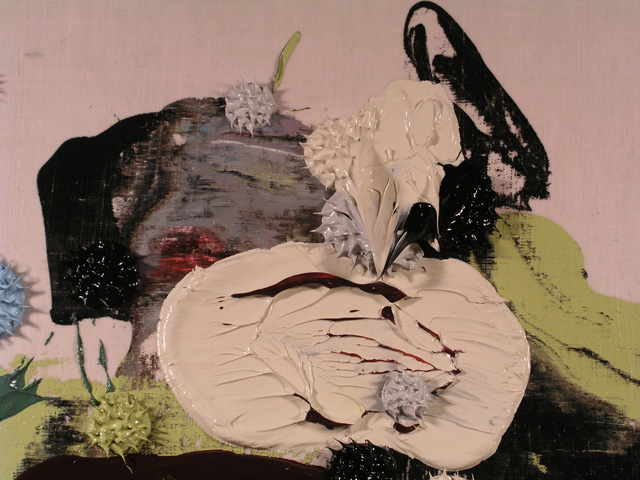
I can relate to John's mechanical printing influenced technique in the flat scraped off passages in my work... and of course to Michael's glug, glug, wading deep into the thickness thing. I feel a little kinship and a betwixt-ness too.
There it is.
UPDATE: A young painter lad* here in Tossa told me today what he thinks about Tapies and Art Informal: "They were artists who acted without thinking..." and he liked that. I think I would like to be an artist who acts with thinking, but more so than a mere rational product of thought... rather, to act (paint, my friends) suffused in thought before, during and after the act.
*It was interesting, by the way, to meet him whilst Stephanie and I were ordering a sandwich and a beer at Bar Savoy. He's in his twenties and he knows about art and painters, he just needs a crash course on contemporary stuff. He told me about Tapies and how other artists in Catalonia resent him a bit because he sucked up all the oxygen here in this part of the country. It seems he's a buddy of a politician by the name of Pujol and the immensity of Catalan power brokers got behind his project as the expression of the Catalan spirit. Tapies has a foundation in Barcelona and he takes up a lot of room in the local museums. I'm just now getting to the place where I can check it all out for myself.
Ain't it the same all over?
Big Party in ChinaTown LA
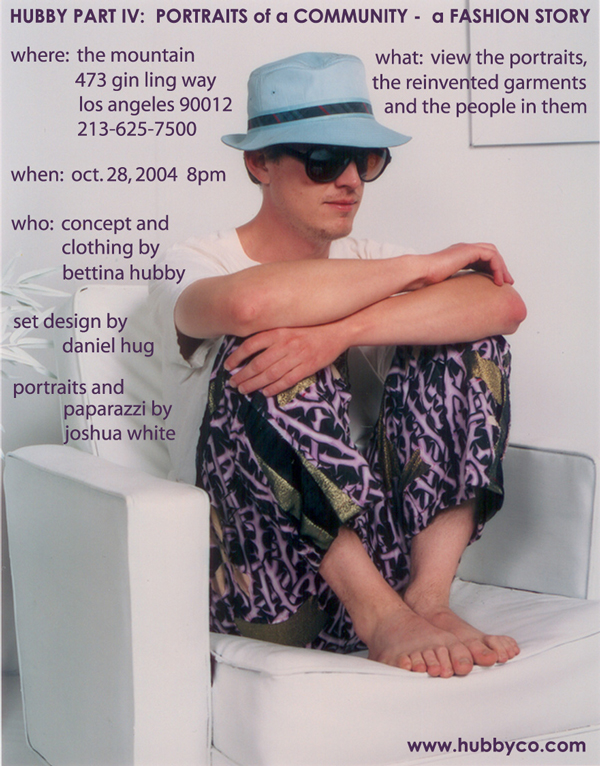
Aw, I wish we could be there for Bettina Hubby's fashion show/ opening in ChinaTown next week. Bettina is an artist cum fashion designer who puts the hand back in hand me downs. (Don't ask me what that means, it just spilled onto this here keyboard.)
Well, you've got to see her stuff. She reconfigures clothing, reversing the polarity of Ready to Wear, one baby step towards tailoring. (I'm riffing here, Bettina.) Yea, that's right... she's the tailor for the 21st Century!
Cheers to all y'all over there in CT/LA! Spill a beer for me at Hop Louie's.
PS: Click the link above and see the show online! ?Muy bien, Bettina! ?Perfecto! ?Ole!
PS2: Skip Arnold gets a little nutty too.
October 22, 2004
SpaceTime like Honey
The ultimate medium. I don't know if the term "frame dragging" means what I am ready to associate it with, image manipulation programs like photoshop or such. This
In the early 20th century, Einstein theorized that the gravity of large bodies such as the Earth distorts space and time, much the way a bowling ball would stretch a rubber sheet held aloft on all four corners.
Frame-dragging occurs, he said, because the Earth's rotation pulls space-time along with it. Salamon likened the effect to dipping a spoon into a cup of honey and turning it. Close to the spoon the honey twists, but the effect dissipates with distance.
Also illuminating was the fact that irregularities on the earth's surface caused bumps and imperfect orbits. That means irregular like the Himalayas.
Cats and Eggs
If Stephanie had a blog, she might link these sites:
They just crack her up!
October 21, 2004
Beowulf-like or Dante-esque?
Here's a very interesting discussion from Neil Stephanson, who recently wrote a book, the third of a trilogy any of which I haven't yet read. It seems he recieved an irritating question at a conference and he was able to squeeze a little diamond from a churlish lump of coal. (Scroll down to question two.)
"Does it bother you that people like Jeffery Archer or Jackie Collins seem to get more respect for their writing than you ?"
Nowadays we have different ways of supporting artists. Some painters, for example, make a living selling their work to wealthy collectors. In other cases, musicians or artists will find appointments at universities or other cultural institutions. But in both such cases there is a kind of accountability at work.
A wealthy art collector who pays a lot of money for a painting does not like to see his money evaporate. He wants to feel some confidence that if he or an heir decides to sell the painting later, they'll be able to get an amount of money that is at least in the same ballpark. But that price is going to be set by the market---it depends on the perceived value of the painting in the art world. And that in turn is a function of how the artist is esteemed by critics and by other collectors. So art criticism does two things at once: it's culture, but it's also economics.
There is also a kind of accountability in the case of, say, a composer who has a faculty job at a university. The trustees of the university have got a fiduciary responsibility not to throw away money. It's not the same as hiring a laborer in factory, whose output can be easily reduced to dollars and cents. Rather, the trustees have to justify the composer's salary by pointing to intangibles. And one of those intangibles is the degree of respect accorded that composer by critics, musicians, and other experts in the field: how often his works are performed by symphony orchestras, for example.
The novel is a very new form of art. It was unthinkable until the invention of printing and impractical until a significant fraction of the population became literate. But when the conditions were right, it suddenly became huge. The great serialized novelists of the 19th Century were like rock stars or movie stars. The printing press and the apparatus of publishing had given these creators a means to bypass traditional arbiters and gatekeepers of culture and connect directly to a mass audience. And the economics worked out such that they didn't need to land a commission or find a patron in order to put bread on the table. The creators of those novels were therefore able to have a connection with a mass audience and a livelihood fundamentally different from other types of artists.
Nowadays, rock stars and movie stars are making all the money. But the publishing industry still works for some lucky novelists who find a way to establish a connection with a readership sufficiently large to put bread on their tables. It's conventional to refer to these as "commercial" novelists, but I hate that term, so I'm going to call them Beowulf writers.
But this is not true for a great many other writers who are every bit as talented and worthy of finding readers. And so, in addition, we have got an alternate system that makes it possible for those writers to pursue their careers and make their voices heard. Just as Renaissance princes supported writers like Dante because they felt it was the right thing to do, there are many affluent persons in modern society who, by making donations to cultural institutions like universities, support all sorts of artists, including writers. Usually they are called "literary" as opposed to "commercial" but I hate that term too, so I'm going to call them Dante writers. And this is what I mean when I speak of a bifurcated system.
Hmmm.... am I Beowulf-like or Dante-esque?
Well, I've never won a grant from the many I've applied for yet!
Passing Thoughts

I was reading a webpage that was making a strong case linking Saddam with 9-11. The pictures of the World Trade Center set me on a train of thought.
Doesn't... it... just... piss... you... off?
New York is lesser without those big boys in the skylline.
And doesn't Liebskind's design just blow chunks?
I think we should build the same World Trade Center buildings again, just change up the volume. So I've heard, the WTC was over programmed with office space, the drama of vertical thrust exceeding the demmand for office space. This means that there's a lot of play internally, both vertically and horizontally.
In fact, the original design is remarkable. Yamasaki, Robertson and Skilling. A decent explanation of the structural design is here although there must be better elsewhere. They inverted the traditional curtain wall approach (with the exterior walls hung off the structural frame) and made the walls structural.
Of course, the original design will have to be evolved so that internal volumes can be carved out freely. Can it be done?
Should it be done? Hell yea. Knock us down, we get back up again. And we'll be better than before.
I google and find a NOVA show about the structural failure of the WTC:
NOVA: I think some people were surprised when they saw this massive 110-story building collapse into a rubble pile only a few stories tall.Eagar: Well, like most buildings, the World Trade Center was mostly air. It looked like a huge building if you walked inside, but it was just like this room we're in. The walls are a very small fraction of the total room. The World Trade Center collapse proved that with a 110-story building, if 95 percent of it's air, as was the case here, you're only going to have about five stories of rubble at the bottom after it falls.
Lotta air. So make the interior airy.
You could place volumetric memorial spaces into the exact position of the original crashes.
And capable of dealing with 10,000 gallons of flaming jet plane fuel.
And Phalanx guns out rigging the window washing divits too. (Check out the link, the fotos are intense! When you look at them, imagine a Robot Overloard meets Mies detail.)
Well, what do you know? It seems someone else has had this idea before, albeit a dry one.
This proposal is hamfisted. Many elements (ground plane above and below, the interior volumes) should be recomposed as radical formal and programmatic departures. Here's a fisking of the engineer's "Reasons to Adopt the Plan":
(Skipping past the boring item one)
... 2. The Twin Towers will reclaim over 10,000,000 square feet of column-free office space.
See what I mean? Ten million is alot of room. (...or is it? How can one check this out?)
3. The Twin Towers will restore revenues from tourism; in fact revenues would increase.
Yea, tell them they can make some money.
4. The site plan offers a substantial, powerful. and appropriate memorial covering 6 acres, 17 when the individual floors of the 9/11 Memorial Museum are counted. The proposed memorial complex not only respects the original Tower footprints, but incorporates them into the memorial in substantive way. The proposed complex contains a Hall of Heroes, a space to meditate, and allows for the interment of unidentified remains.
"Hall of Heros"? Yeeeesh. Libeskind likes this mawkish tripe too, probabaly his influence.
5. The shopping complex that was housed one level below grade, along with street-level retail, will create many jobs and stimulate the economy and bring in substantial sales tax revenue.
Flip the dollar bills under our noses again. About as uninflected, neutral and white bread a treament... no vision.
6. A sensible arrangement of tax abatements and incentives could entice businesses to choose Lower Manhattan, and the Twin Towers in particular, as their location to conduct business.
Flip the dollar bills under our noses yet again.
October 20, 2004
Progress Report: 10/19/04
It's time for another job site inspection.
So grab your punchlist, let's check out what's happening with the nieghbor's new house rennovation:
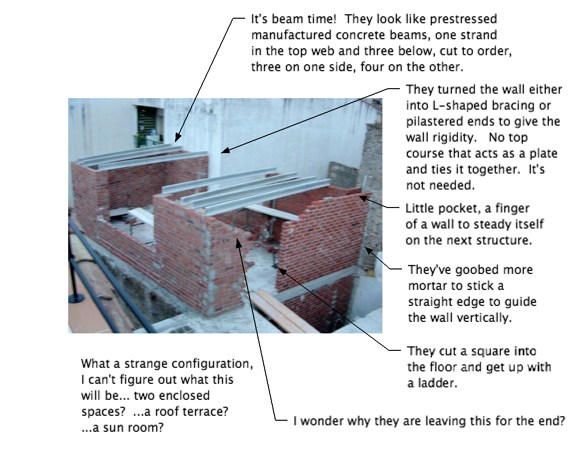
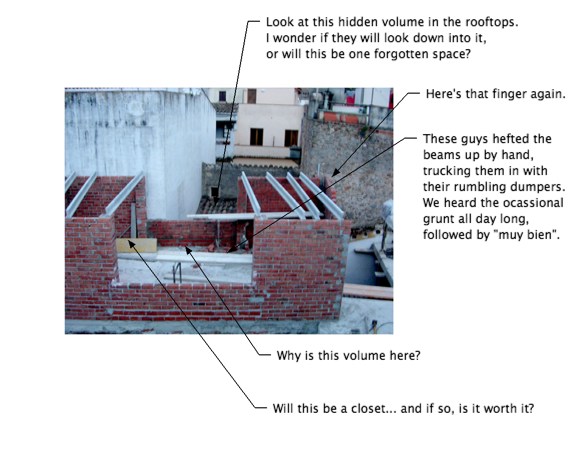
October 19, 2004
Juno is Gone
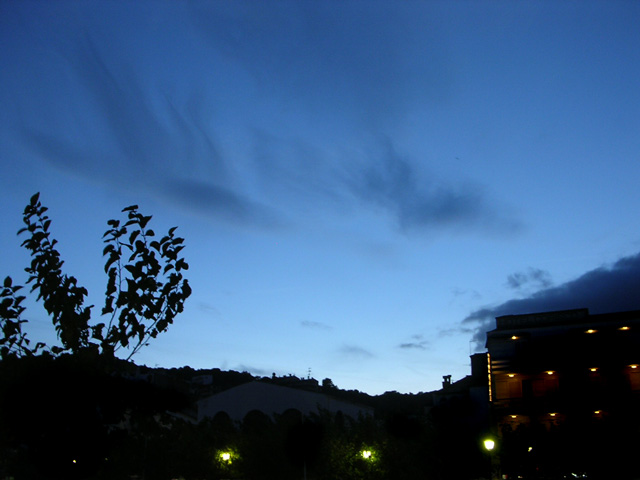
Juno passed away late yesterday.
Usually, I try to keep this blog about the studio and issues surrounding painting without getting too far out into the periphery of that surround. And even though I consider this blog to be among other things, a bibliography of sorts, my dogs have certainly been a constant companion in the studio.
With rationale aside, we loved them so... we loved them so.
Eleven years of owning large dogs and eighteen years of owning animals is over. No more animals for a while. A new-now.
Despite having this sentimentality alarm lit on my dashboard, I think a small tribute to her and the era of owning dogs is fitting. An era, one that had lasted for us eleven years.... is over.
So click the link at your own risk all you no-nonsense, hard bitten, clear eyed Spock people. I hereby warn you.
Tears won't stain your keyboard.
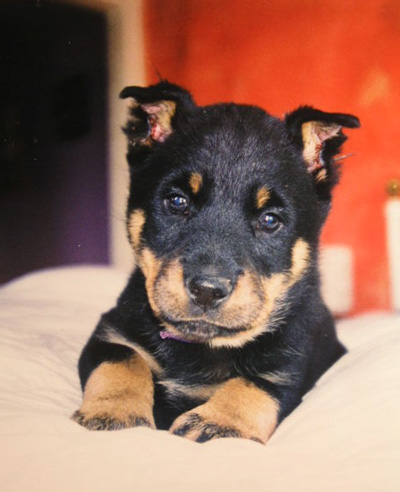
Juno des Ombres Valeureux. Juno fresh from the farm.
Check out the meaty ears... don't get upset, it's a breed standard, a French thing. Juno does look she's been through the grinder though.
But Juno was our second dog.
The first was Index:
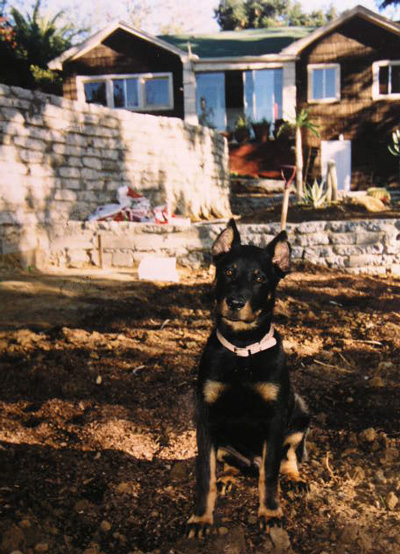
Puppy Index in the backyard, Echo Park.
One day Stephanie came home with a dictionary of dogs. We had just bought our first home in Echo Park. Echo Park is on the tail end of the Santa Monica Range. The first suburb of Los Angeles, some of the streets there were too steep for cars, so they built stairs instead. Our house was on such a street.
Every night, we would look through the book and after many nights of pillow talk, we alighted on the Beauceron as the favorite: strong, devoted, requiring a firm hand... well, here's the description from a random website:
The Beauceron is a brave, faithful and highly intelligent dog. Fearless, vigilant, and patient, the Beauceron has an aptitude for obedience training and is known for his quick and thorough?understanding of his master's desires. They are an excellent natural guard dog whose appearance and demeanor command respect. The Beauceron is happiest when it is working or exercising in wide-open spaces. They are instinctive herders who will herd everything in sight unless trained to do otherwise. Calm, obedient and very loyal, the Beauceron is always eager to please its master. They like to know who is boss and then they follow. They are generally good with children if they are raised with them from puppyhood, although this large energetic breed can be overwhelming to a small child. Even as a puppy at 3 months old it can weight 40 pounds. The Beauceron can be very protective. Thorough training with a firm master is absolutely necessary. The Beauceron will obey commands from all members of the family if trained to do so. This breed is sociable with dogs they know, but they are highly territorial and will not tolerate an intruder.
Oh yea, we were house robbed a couple of times. That was no small factor.
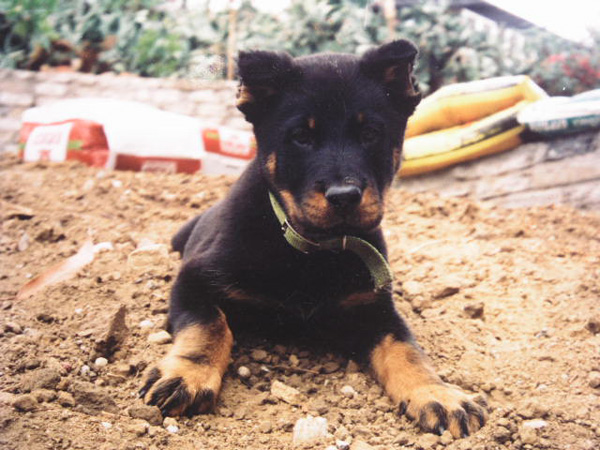
Here's index, fresh from the farm.
The names have to conform to the alphabet. 1993 was an "I" year. The breeder bred working dogs and some of the work was protection, so sometimes the names got a little visceral: Havok, Champion, the famous Glock (our name, his name was really Gluck), stuff like that. We wanted a strong name but a little more neutral with the agro. Exasperated, we were having lunch at our favorite Mexican Restaurant in Highland Park: "La Abeja", flipping through a telephone book as we were waiting for our Enchilada Verdes (muy delicioso, my friends) and I realised that there it was at the top of every page: Index des Ombres Valeureux.
Les Ombres Valeureux are the breeders in Aguanga California, desert country south of Palm Springs, North of San Diego, big rock country like the Flintstones. They matched us with both dogs, studying personality and tracking behaviour with notes and color collars. Index was the empath, protective of the underdog puppies.
Here's some history from their website:
The Beauceron is a distinct French breed of herding dog. Though almost unknown outside of France, the Beauceron has a long history. It is a very old breed developed solely in France with no foreign crosses. The Beauceron is a dog of the Lupoid type. The earliest record found so far of what is thought to be this breed dates back to a renaissance manuscript of 1578. In 1809, the abbey Rozier reported plain dogs guarding flocks and herds. In 1863, Pierre Megnin differentiated, with precision, two types of these sheep dogs: one with a long coat, which became known as the Berger de Brie, the other with a short coat, which is know as the Berger de Beauce, or Beauceron.? Like other sheepdog breeds, the Beauceron is easy to train to assume tasks other than the care of flock or herd. These dogs are used by the French police and Army in much the same manner as German Shepherds are used in North America. The calmness of the breed, and its ability to follow commands without hesitation, has been well illustrated during both major wars in Europe.
When we came to the Skinner's place to choose our pup, Juno was kind of to herself, probably pissed off with the ear job. She was the oddball, not the runt but she went off on her own.
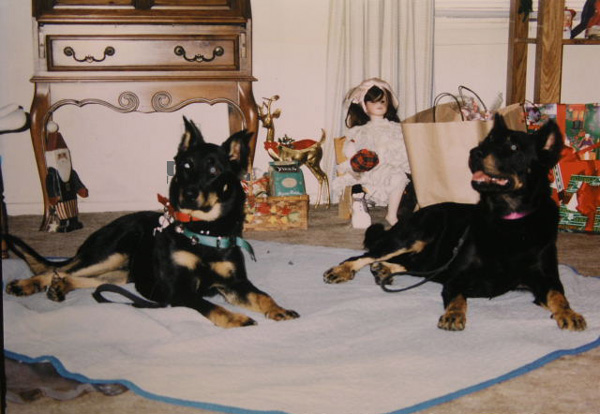
Here, two young vital animals in full bloom and vigor. Winter holidays, 1995.
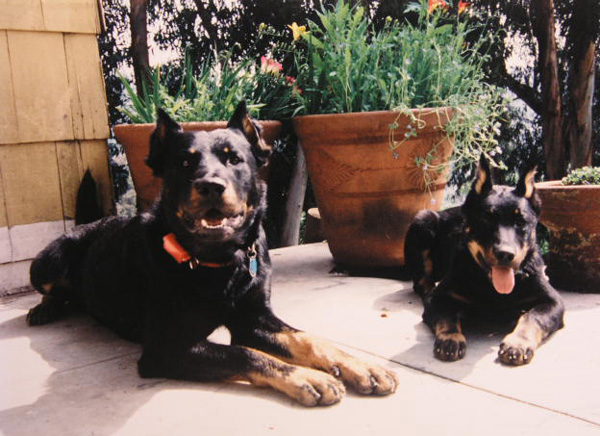
Index loved to play ball. I mean PLAY BALL. He would take line drives as hard as I could pitch them and drop the ball in your hand for another round. After a few years of this I began to develop shoulder problems. Rotator cup?
Index died when he was five, lymphoma. A gut wrench I knew we would experience again as we did yesterday. I had a studio in ChinaTown LA then.

Juno traveled with us from LA to Texas for a year and now to Spain (most of this transistion is in blog archives). We could hear her barking in the cargo hold of the plane as we landed in Barcelona. Later, as we disembarked, we found her all alone in her crate in baggage claim. No one checked us out, anyone could have taken her.
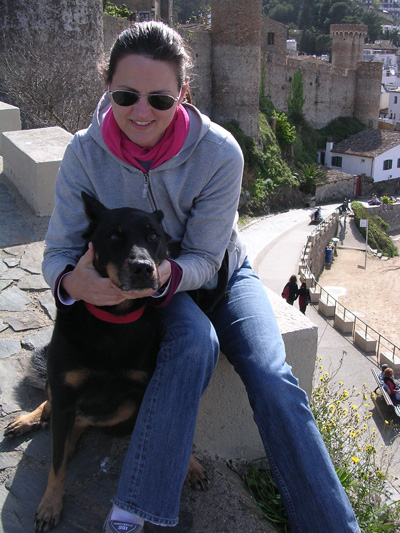
It was in Texas that we learned of her Mast Cell Tumor. We had it cut out but the biopsies were of the worst grade. The vet estimated six months. That was over a year ago.
Every day was a gift. We spoiled her terribly, but she was too good a girl to let it go to her head.
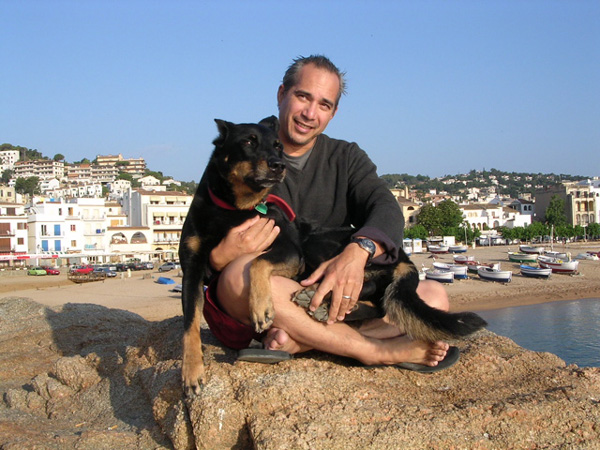
I'll miss the morning walks to the beach. We have no yard to speak of, so we had to take her out three or more times a day. And since we were living on borrowed time, each walk was a clarifying experience.
Walking out on the rocks will reverb with those mornings for a long time to come.
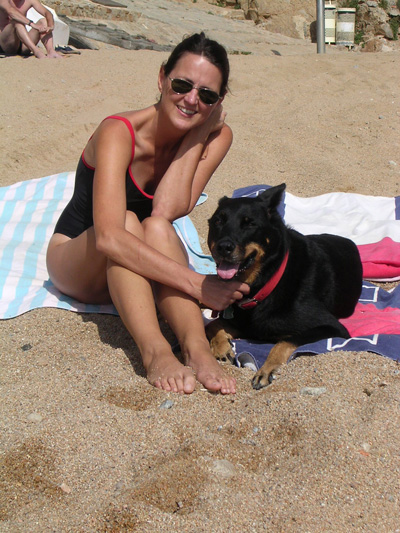
Our house was a fit for three, and now we have to live in it enough for it to feel a fit for two. One thought was to travel, to get out, to go to Haarlem for the opening or go to Rome or something. But once we returned, the house will still be a place fit for three. We would expect to see Juno come around the corner any time now.
We decided to stay put, to live out a new-now, to make our house fit for two. Every little thing has lack: the end of the meal with a scrap for treats, get out of bed and try not to step on her tail, even the simple act of walking down a street begs the loving chatter: "Let's go! Let's go! Easy girl. Heel. Good Girl! No, don't eat that bubble gum. Good Girl!"
Emotional phantom limbs.

Dogs aren't people. But they seem more like eternal kids, furry ten year olds.
Dogs don't complain when they are sick. They don't dwell on it, they aren't probably capable of self consciousness and hence, self pity. So they don't compound a bad deal with regret.
Index wanted to play ball as his liver was failing. Juno gave us lick and wanted a belly rub as the Vet inserted the last needle.

Goodbye Juno, baby girl.
We love you.
October 18, 2004
Colder
Neighbors have loaded up with firewood. We smelled the first plumes then, I imagine they lit a brace to check the system out, say hello to a fire. But for the past few days, there's no smoke from the chimneys yet.
We decided to wait until the last minute. This way, our bodies can adjust to the colder weather.
Self abnegation. Say no to pastries. Cold showers. Thirty minute runs. Skip a meal. Shower every other day. Floss all the time. (That's right. When was the last time you flossed?)
We'll see when the locals get chilly.
October 17, 2004
Cart?n
Back in the States, when I needed to build a box to ship works out, I would find large 4'x8' sheets of cardboard (carton) and custom build the proper container to get the work out safely.
I still custom build here, but there's no large sheet stock available (that I can find yet). I'm sure they exist somewhere in Catalonia, but not having a car is a hindrence. And Tossa is too much of a pueblo to have an Office Depot or cardboard box manufacturer nearby... or supercool art supply store (like Roark, in downtown Los Angeles) either.
So, I walk the streets looking for scraps. I've found this dumpster where the local Tabac shop tosses refuse. Perfect, beautiful boxes. Not wet from fruit or meat or fish like the grocery stores. Large appliance boxes are good, but not as cool as the ones from the Tabac store.
The names:
L&M (I haven't seen those for a while.)
Marlboro Lights (My dad's favorite.)
Lambert and Butter (Never heard of them before.)
Ducados (What a name!)
I almost hate to cut them up.
Morning Singer
There were times when in those moments where my dad was exasperated with me, whe would admonish me thusly:
Dennis, you're like a chicken. You're born in a new world every day.
Oddly, I never felt stung by it. I seem to remember blinking like wet chick at the times that I would recieve this reproach, wondering what it meant.
Kid Billy Pilgrim.
Later, I would consider that it was not such a bad place to be afterall.
The New World
***************************
I've been waiting until the last moment to box up these recent works on paper.
I've been lucky in that all of my work goes out to my galleries and everything is still in play out in the world. I have work stashed in our attic in Los Angeles, but surely not as much as I've seen other aritsts have. And while I am thankful for this circumstance, it would be nice to have more of my stuff around. (But then again I might chafe at the burden and pack them away anyway. Maybe later if things are good, I can buy back the work like McCartney and Jackson. ...er, hold off on the offers, my erstwhile collectors... I'm not there yet. Besides, if I come snooping around like that let me now issue a fair warning that that would be a sure signal to keep the work!).
Anyways, my studio is always empty as I begin a new project.
A new world every day.
**************************
Remember Cantas Ma?anas?
October 15, 2004
Group Show at Tanya's
Group exhibition / Paintings
??21.10 t/m 14.11
Pia Fries( D),
J?rgen Meyer(D),
Dennis Hollingsworth (USA),
Angela de la Cruz(UK)
Adrian Schiess (CH),
Paul Doran (Ir)
Tanya Rumpff was kind enough to include me in a group show at her gallery in Haarlem. She saw my work at Andr? Buchmann's gallery (probably an art fair) and I'm touched that she would seek me out. After a studio visit last month, we agreed to work together and the first solo will be next Fall.
I'm happy to be in the show and learn more of other painters here in the EU. So, here's the result of a swift google search:
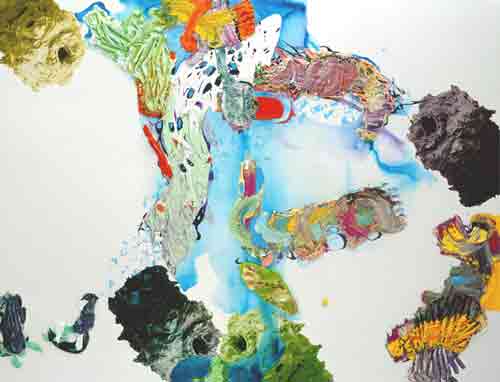
Pia was kind enough to visit me in LA a while ago. She's the only artist in the show I know. So, I'm curious to see with you, dear blogreader, what the other artists are up to.
This, from a site I've never encountered before, NewYorkArt.com:
The paintings are topographies, which even their made-up names--Belsize, Buckhurst, Caspian (not made-up), Vivelin, and Tellson--seem to indicate. Their terrain is whiteness, light that suffuses every color, an absence of darkness because these forms are constantly emerging out of the whiteness. They exist in light and are created not to defeat it. Thin washes, such as the river of blue running down (or up) the center of Caspian, are both evanescent and powerful, creating a kind of free-form undertow that pulls the heavier thicknesses of paint together. These thicknesses have a sense of hyperreality that pushes out into our space from pictorial space in very distinctive patterns that persist despite occasional interruption. And then they gather and form new vortexes, still remaining distinctive in their shapes, colors, and movements, and always intensified by light. Every form is changing, becoming, and at the same time definitive in form, like a flower or any detail of nature.

J?rgen Meyer was tough to google. He's using lots of resin in a way that bears some resemblance to work I was doing in the early 90's. Here's a clipping from ArtNet's review (Rosanne Altstatt), Report from Dusseldorf:
There the canvases by J?rgen Meyer, lavish brushstrokes in orange oil layered over a translucent yellow resin ground, remind me of a little kid in a museum I heard say "I want to bite it!" when confronted with a work by Hans Hofmann.

Angela de la Cruz is tearing up the turf it seems from all the google hits on her name. This, in her own words, from ArtFacts.net:
"The first time I cut the canvas, which was in 1996, I hung it in the corner and it became like an animated object, but it retained all the characteristics of painting. The painting was called Ashamed. So even though the paintings have got this object-like quality they still remain paintings. It's very important that painting is stationed within the parameters of tradition, otherwise it has no meaning. I am trying to research the language of painting."
More stuff here.
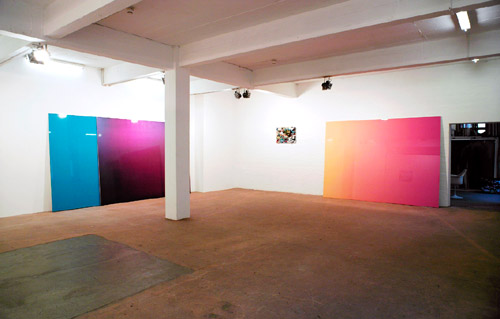
I got this Adrian Schiess pic from that strange website that treats artists like stocks to be traded in the marketplace (shades of Public Offerings), ArtFacts. Click the link to see the strange statistical graph plotting his rank (?) over time. Hombre.
Here's something culled from a place called Villa Arson in Nice:
Adrian Schiess is a Swiss artist. For many years his works have been shown flat on the ground, as if deposited there, often on battens. These works are predominantly painting, needless to say, and "monochrome paintings" what is more, but not pictures in the strict sense of the term. They are part of a line of thinking (literal and figurative alike) about landscape, and about the links that the work has with what is around it. Like the painted metal of a new car, Adrian Schiess's paintings reflect their immediate setting, and emphasize the depth. But on the other hand, they also alter its qualities, by the intervention of colour and its variants.
And here's something from ArtForum at findarticles.com, a great reference site.
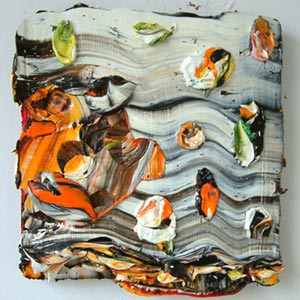
Paul Doran is out of the MFA block and running, many many google hits. This, from his Dublin gallery:
As Doran himself explains :" The edges of the canvases spill over with paint residues. These residues affect the material presence of the painting as object, as the paint no longer represents a window onto an interior space but comes off the edges of the canvas interrupting the works? exterior space and thus that of the viewers. "
Posted by Dennis at 7:34 PM | Comments (1)
October 14, 2004
Subterraneo
Tonight we punted dinner and went to Restaurante Luis for a quick pizza. Talking to the owners (who are so happy and smiling so sweetly, so much so that it's hard to walk by sometimes) and they tell us of stomping grapes when they were kids at Can Marcelino, the old cava (winery) that is now our house. I asked her about the basement described by others, and she said yes, there is one. She said that people used to hide their boys there for fear of being conscripted into the Civil War.
Our house has a mysterious basement. How big is it? I imagine low arched ceilings and about three feet of standing water. Maybe its a little onion cellar, not much more than a pit? Maybe it's a Piranesian fantasy! Thick arches and stairs and rooms that leads to rooms to rooms.
Everyone drops the idea of treasure when we speak of it. PIRATE TREASURE! A Disney image of a chest laden with pearls and brooches and coins silver and gold. The lady at restaurante Luis tonight mentioned silver coins (gold for the upper classes) that are hidden here and there by the ancient Spanairds as insurance against calamity. "Plata muy puro!"
The mystery deepens. Where is the entry to this cellar? When we returned, I started knocking on the floor, stomping for the hollow sound.
Progress Report 10/04
Continuing to report the progress of the construction next door, here is the progress report for the month of October. These guys are working hard, through holidays, early in the morning to late in the evening.
Let's take a look:
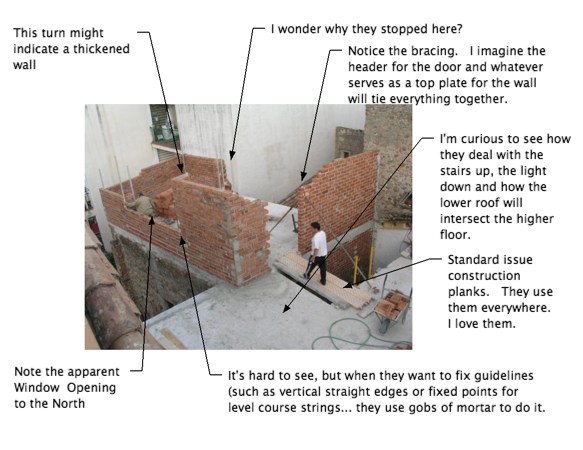
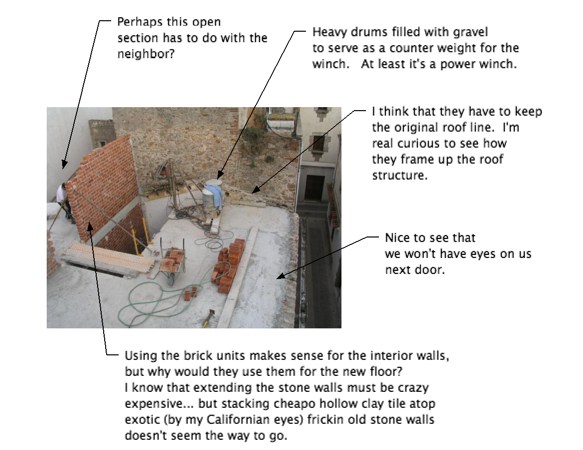
And here is where I took these shots from, a 180 degree pivot:
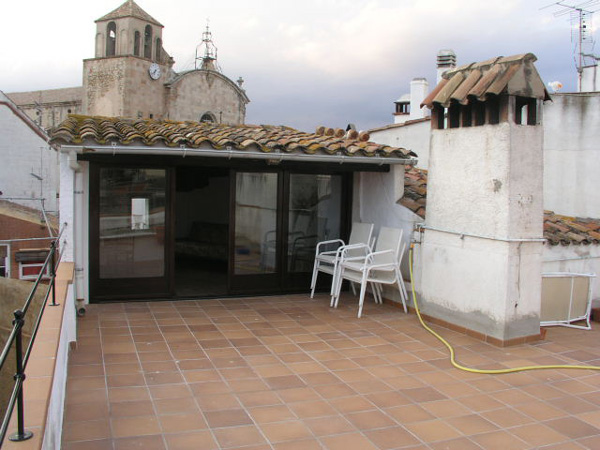
Keep 'em Guessing
As science is figuring out how to allow machines to see, we get to look over thier shoulders (scientists, that is) and glean something interesting now and then. I've just found this article about image recognition, via Wretchard's Belmont Club. Check it out:
Our eyes provide us with an abundance of information about the outside world. Thanks to vision we become aware of the objects and living beings that surround us and represent their form and properties in our brains. Computer vision researchers aim at reproducing this capability in machines.Vision is difficult. The images of a human head and a melon are very similar if taken with the same illumination, whereas two images of the same head taken under different lighting conditions are extremely different. Yet, we have no problem in telling which is which. The image of a tree is composed of an intricate pattern of lights and darks, greens, yellows, and browns and yet we are able to perceive it as a single object and simultaneously to perceive the leaves and branches that compose it. It is obvious from these examples that the metric in the world of images, i.e., a naive distance measure in the extremely high-dimensional space of image intensities, is not very informative for extracting concepts from images. Different objects may produce the same image and, vice versa, the same object may give rise to very different images depending on viewpoint and lighting conditions.
Knowledge of the world is vital in resolving these difficulties and taking advantage of whatever little information an image can provide. Many visual illusions demonstrate that the visual system is built to take educated guesses on the nature of stimuli.
Fiesta de San Grau
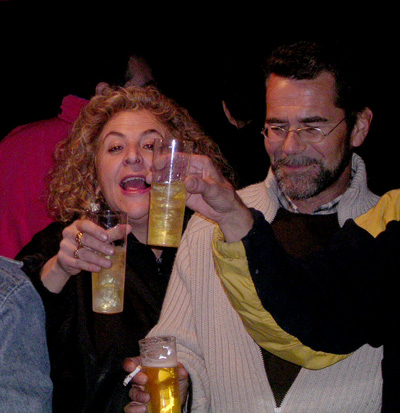
Even cities here have birthdays, and for Tossa, it's called "San Grau". Every year, the residents of Tossa go to a nearby mountaintop and have a picnic. And over the years, they've been having concerts on the night before the picnic, camping for a few days prior, partying down muy rustica. Here's a few fotos for you all:
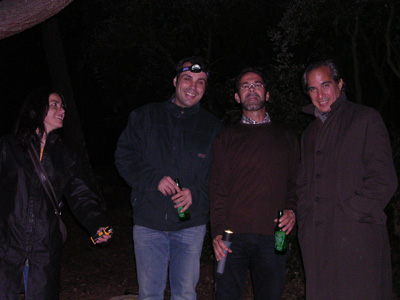
Of course we went with our friends Kiko and Teresa, and Kiko's best friends Joan and Monica. Joan and Monica own and operate a restaurant and a bar in Tossa, cool people. Joan is the type that likes to pull your leg, and I've been told that when he gets to know you, he can really stick it in. For example, I heard him greet a buddy, Nacho by calling him a "canta ma?ana", which translates to a "morning singer"... someone who wakes up singing in the morning... in other words, cluelessly happy.
I await my own comeuppance one day soon, I hope. They're a fun couple.

Mi amigo fuerte, Kiko.
On the mountaintop, people were camping all around in the darkness. The season for open camping fires was yet a few days off, so people were sensitive to the prohibition against campfires, the place was pretty dark. What fires did occur were hidden, on the q&t.
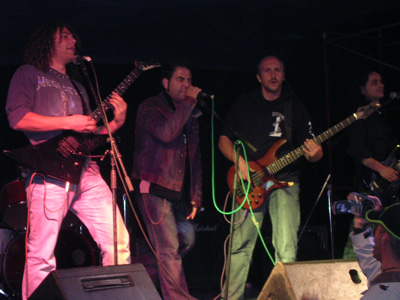
The bands rotated one after the other. People were pretty enthusiastic, often singing along, wriggling.
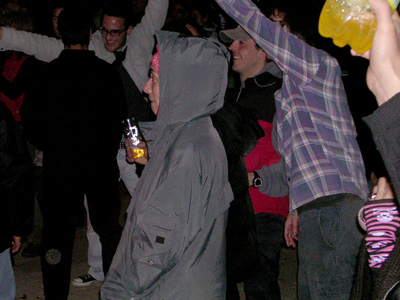
A shot of the audience for you.

Every song on the stage was dedicated to Nanni, owner of the Hippy Shop, here in Tossa... rockstar that he is here. I had to get a celeb shot in there.
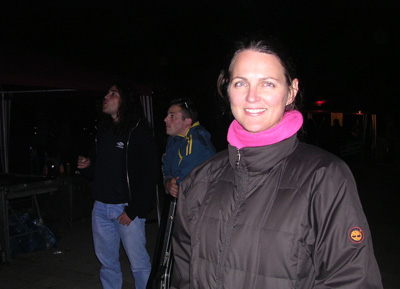
Stephanie is getting ready for the cold weather. The visit to the mountaintop is a good rehearsal for what is to come.
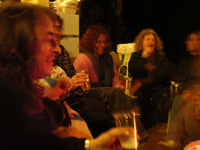
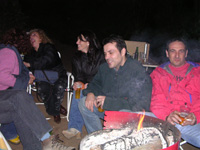
At around 3:30, we thought we were heading home... but we should have known better. We stopped at a campsite of Kiko and Joan's friends, people who own another restaurant in Tossa. I forget their names. (Pictured to the left.) Thier encampment was tucked into hillside. They strung up a sheltering tarp and a brazier provided heat. Off into the back behind rocks was a generator to power a small refrigerator and a nearby beer keg and tap kept the party rolling along.
We returned home before the sunrise, about 6:30 am. And that is starting to feel normal to us now.
Three Paintings on Paper
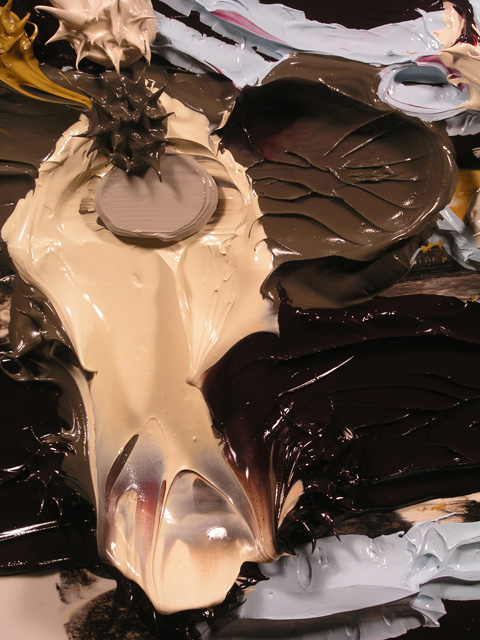
Scintillating ruminations follow...
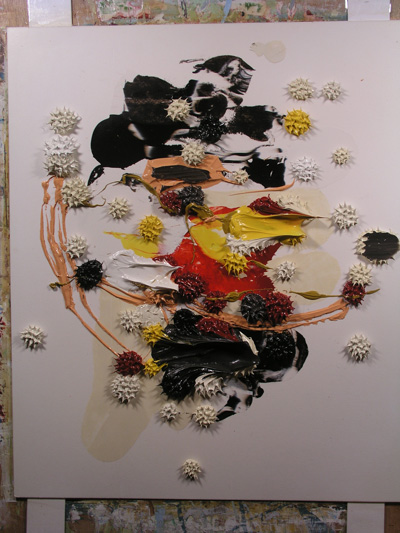
I've always thought that the entirety of this body of work (now passing 220 in number, not including the works on paper) is a chain where each painting is an argument (I'm not sure that this is the correct term) one leading to another. The paintings here follow from the last work on paper shown in this post. And they are a development of strategies explored in the tail end of the body of work sent to Z?rich last August.
What I am pointing to here is the incorporation of marbleized passages and the open architecture that has to happen if you want to see the first marbled moves.
I tend to swing from light to heavy, and back... this one being one of the lighter ones.
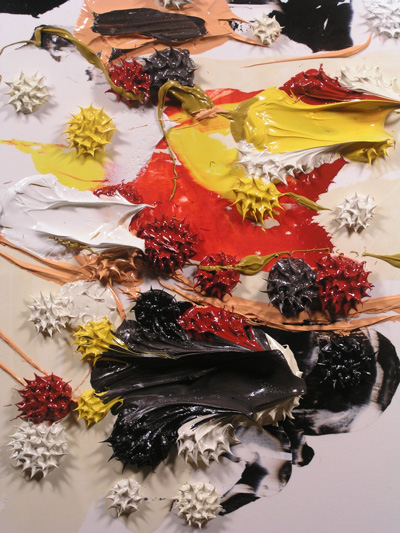
I think we see with a synthesis of views panoramic, close up and a memory of what had been seen before. Showing the paintings with photography, I think several images and this chatter are neccessary here to translate the experience.
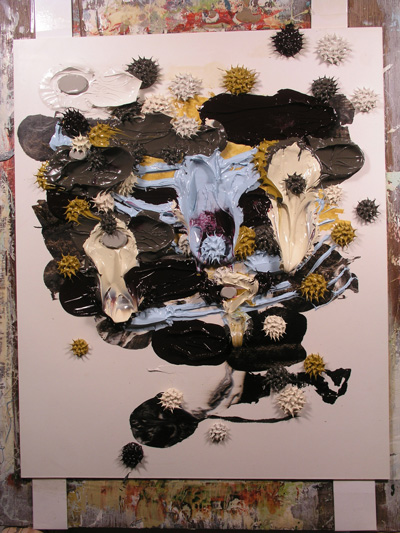
And as I go towards the abandonment of density, here I try to keep enough air within and especially surrounding the image/mass.
Each pass into the painting results either in poetry or noise. Often the poetry occurs soon, too early in fact. It slows me down, partly an effort to learn from it but also an effort to summon the wherewithal to destroy it with the next action (whew, what an art-theory-loaded word, "action"). I can hear the voices of friends fromt he past: "Stop right there, don't ruin it!" And as tempting as it is to stop, I have other objectives in mind, so I soldier on. (The friends roll their eyes.) The isolated minimalist frozen gesture was done by David Reed and others in late 80's and early 90's NYC. I prefer not to reprise that moment today.
Often, crossing the threshold of spoiling something good keeps me frozen in the studio, contemplating the painting for far too long. And the paint is drying all the while. And just as often, the subsequent great "moves" (I'm not entriely comfortable with that term) need a besotted bed of paint-experience to pull victory from the jaws of defeat (verbage here is a little over the top... but it works because a bad painting is such a bummer that when you can turn it around, it's "YES! YES! YES!"). You have to be willing to paint past where you thought you were going to find a new place entirely. (And conversely, you need a place to go to as you start off.)
It's about having the nerve to go too far and having the sense of knowing when to stop. Hey, Rauxa and Seny!

(A note on the colors: It's hard to discern the color of a deep earthy red that is flattened out here in these jpegs.)
Carnal.
Flesh.
Mortality.
The pain of existence.
Vanititas.
Watery Greco eyes turned up to heaven. Sweaty trembling hands clasp in ecstatic anguished agony.
Martin Sheen writhing, a purgatory of a night in a Vietnamese hotel room.
... uh...
Coltrane in Tokyo. (I wish.)
(Just go with it. Winky Emoticon= ;-I )
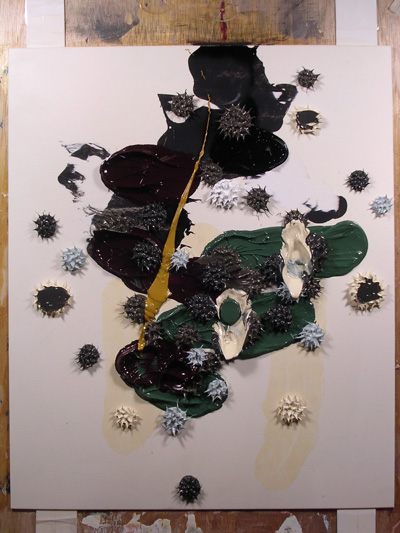
And now for something different, clear the pallette.
Take a shower.
Shake it off, man.
Restring yourself.
Use the chops to sing a clear note.
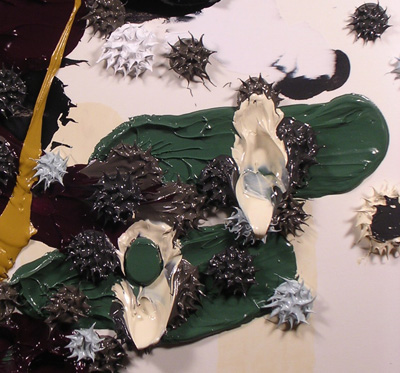
I remember the movie They Mystery of Picasso". He would paint, "thinking aloud". Meandering. (However breathless poplular descriptions evoke the charging bull and blazing eyes.) A mess, a disaster in the process... he would then take up a new glass (canvas) and apply the things he learned from the previous car wreck of a painting.
Both the car wreck and the recovery are important, one wouldn't be possible without the other.
October 10, 2004
Trembling...
...with anticipation:
The BrainGate? System is an experimental or investigational System that Cyberkinetics has begun clinically testing. It is not an approved device and it is available only through clinical study. The system consists of an implantable sensor that is implanted on the motor cortex of the brain and a system that measures and interprets signals from the brain. ? It is hoped that the BrainGate? System might some day allow people unable to use their hands to potentially communicate with a computer using their thoughts.
October 9, 2004
Red Eye Radio

The news today, other than John Howard's win in Australia, is that Doug MacIntyre is moving his radio slot from the midnight ("boiled owl") position to the coveted morning drive program.
Another promotion!
Late night radio is a funny place (in the SouthWest USA at least), a place where I would listen to Terrence McKenna talk about datura (KPFK)
We were with shamans at one point in Peru, ayahuasca shamans, and I was aware of an admixture plant that was stronger than the admixture plant that they were using. And I kept asking this guy, 'What about so-and-so? Why don't we do that?' And at first, all he would say was that it's not for Christians, which was strange because he always knocked Christians. But I kept pressing, and finally he said, 'We just don't do it that way.' And I said, 'Why not?' And he said, 'Because it's mali bizarro.' (laughter) You know? And I said, 'Isn't that what we're shooting for?' (laughter) Apparently not. A curing shaman wants to be empowered to cure. He doesn't conceive of himself as a Magellan of the phenomenological realm, who's setting out to circumnavigate the mental universe in an evening....(Magellan?) or Art Bell (KFI) and get all spooky while I worked inthe studio. MacIntyre has a regular-off-the-shelf call in open topic radio show, except what he pulls off the shelf is wonderful and invested and generous.
I used to listen to his radio show in LA, perfect for the wee hours. He would bring in Jazz figures, the insider's ...hipster's (in a good way) story of the world of jazz and lounge music. Once you get on his site, he's got his signature intro mocked up as an groovy airline attendant cooing about the tray tables up and strap on the seat belts for take off, a radio show as a Rat Pack swivel hipped finger snappin' excellent night out. Then it continues with David Patrone singing "Come Fly With Me", and all this will play when you click the link.
Instinctively, I reach for my martini.
It's too bad KABC doesn't offer an internet streamed archive of his show. You've got to tune into the station via internet radio from midnight to five am, California time. Or if you're an Angeleno, tune in when you get up in the morning.
On more than one ocassion, I've heard people call in drunk to hear Doug connect with them and offer a way back to health. The compassion. They don't always take it . I don't know Doug's personal history, but it's amazing to hear real empathy en vivo.
Here's how he describes himself:
DOUG MCINTYRE pilots Red Eye Radio, Flight 790, on Talk Radio 790 KABC in Los Angeles. Heard weeknights from 12AM to 5AM, Red Eye Radio is an eclectic mix of politics, history, current events, comedy, music, sports, books, and movies. Doug will talk about "everything and anything" and proves it nightly.
For nearly twenty years, Doug has worked as a television writer and producer, having written for Married? With Children, WKRP in Cincinnati, Full House and Mike Hammer, among many other popular shows. He has also written for major publications, including American History Illustrated, LA Jazz Scene, Dragonfly Magazine and authored the comedy paperback Cheap Advice, published by Time/Warner Books.
A frequent presence on television, Doug was a guest 12 times on Politically Incorrect with Bill Maher, as well as CNN?s Talk Back Live and the FOX News Channel?s hit shows, Hannity & Colmes and The O?Reilly Factor.
Born and raised in New York, Doug moved to Los Angeles in 1985. A graduate of Stonehill College in North Easton, Massachusetts, he holds a degree in English Literature. He taught a class in sitcom writing at UCLA and is a popular speaker at civic and business gatherings.
Doug is currently finishing his first novel, Frank?s Shadow and his critically acclaimed series on the American Revolution; Liberty?s Kids is currently running on PBS.
Red Eye Radio is a program for conversation, not sound bytes and ad hominem attacks. Smart, funny, civil, and occasionally weird, Red Eye Radio brings live and local overnight radio back to Southern California.
It's fantastic to listen to LA radio here in Tossa. Perhaps we should complete our immersion here, but there's nothing like that feeling of being able to keep a pulse on a place you know so intimately from so far away. To hear the traffic report and the daily weather and local news, so easy to visualize being there.
October 7, 2004
Rabbit Hole
You've got to spend some time with Matthew White. Here's his home page. Here's his Atlas of the Twentieth Century.
Just. Go.
And pack a lunch. The guy's a freak.
This, via Winds of Change:
An interesting website that can take days to absorb is Matthew White's Homepage. The site contains various bits of visual historical-geographic and statistical information. It's a marvel to study. One page is entitled Who was the Bloodiest Tyrant of the 20th Century? and compares raw numbers of murdered millions at the hands of various tyrants.
October 6, 2004
Vertigo Check
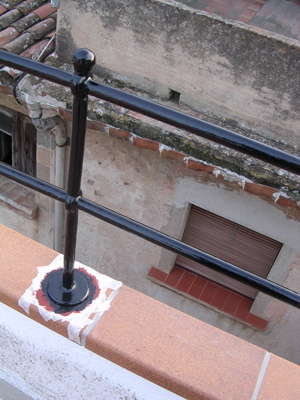
We finished the finishing touch for the terrace, a new rail. The metal workers installed it in a morning, funny guys. We painted it quickly, two coats of primer and two of a finish. Great weather, the construction guys next door played their radio loudly, the whole neighborhood gets to listen in while we listen to the people passing in the street below, seagulls in a crowd above our heads.
Whilst documenting the fine paint job, I wanted to shoot this elevation of our neighbor's terrace across the street for your viewing pleasure:
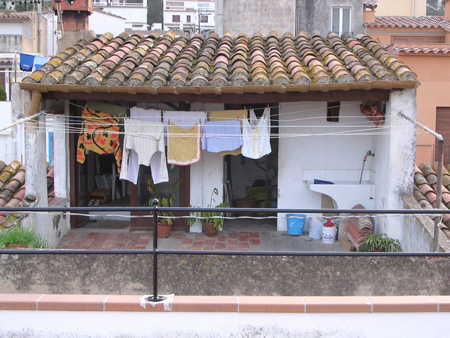
I see they are breaking out the sweaters. They use the terrace as a utility room, most everyone having a sink and more often than not, a washer and dryer... sometimes air conditioning equipment. And laundry. And a few plants. They are not hanging out there, which is cool since we will.
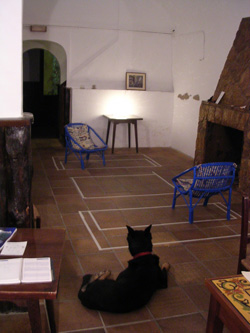
Meanwhile, we are feathering the nest very slowly. Every small improvement is a big deal, new rail here, a new lamp there, and we savor this minimal cosa life. Here, we are trying to visualize how couches could work. Those, a big low table and a toasty fireplace could make a winter pass very nicely. We'll see.
Abundance. Think abundance.
October 5, 2004
Modern City Planning
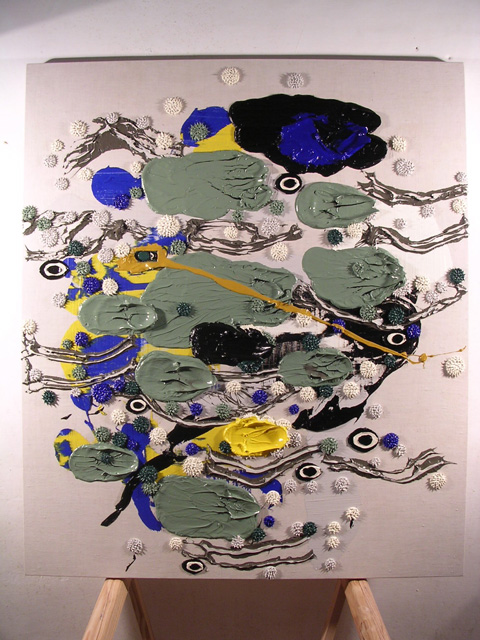
I wanted to finish this painting before Gil and Daryl arrived last week, and since I paint alla prima (within the time it takes for the paint to begin drying), I finished just in time. But the painting bugged me. It lay on its' back in the studio during their whole visit, I would walk by and stare at it, wondering what lack it had that kept the door from closing.
Here's how it looked before:
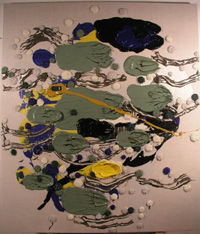
I was able to capture a good aspect in this jpeg, but it didn't hold up in other lighting conditions. In the shadows, in daylight, with ambient light, the composition washed out. Whatever was good in the skein of forms was flattened by the colors in which the Cad. Yellow Light and lightened French Ultramarine is countered by a green which is actually a mix of those colors. There's something about throwing down a melange of color, scooping it up, mixing it and a reapplication that seems appealing to me now.

It's not too easy to lay down the fractile (grey) forms, it requires a stiffer carboard (I work with shears and cardboard all the time). Like the work on paper that preceeded it, the bulk of the composition... worked like a bulk would, and the oval stacks tend to punctuate and punch up the composition that by and large relied on other qualities other than color to carry the load.
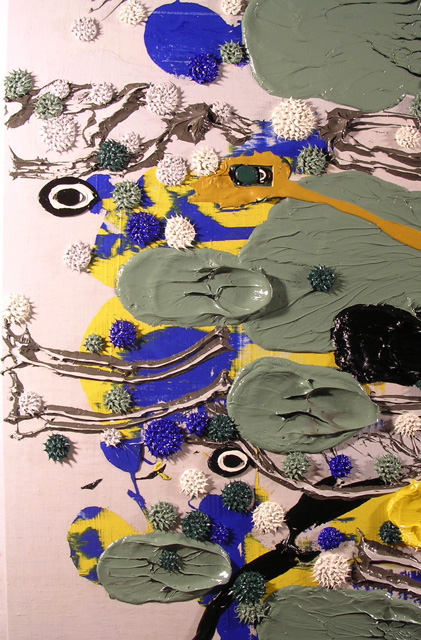
And as for modern city planning? I paint the cuadros both vertically and horizontally... mostly looking at it vertically and laying a majority of the licks to it whilst it is flat on it's back. I can't deny the appearance of architectural models, especially city plans (I remember Frank Lloyd Wright's Broadacre City model, seen once at MOCA LA). My thoughts about the city tend to align themselves with Leon Krier's distinction between the traditional human scaled city (a city of urban quarters, each no larger than a person can walk in fifteen minute's time) and the modern zoned city (a planned distribution of uses into an urbanism sectored: a bedroom community there, an office park there, an shopping center there, etc.). The words "Modern City Planning" popped into my head, even though I've nursed these ideas before. A rare occurance, this happens now and again... i thought I'd let it stick.
Looking at the painting on its back with the raking daylight, the distribution of pigmented forms evokes an urbanism. And I thought how representation maps cleanly over the "Human City" the former category marked by human scale. In this place, each part defers to the other parts and one moves from one to the other in transitions. Here, the individual defers to the group. In a modern city, each part is articulated and distinguished from the rest. Context is a circumstance rather than the reason for being. And figure dissolves into field (emphasis on the verb as a state forever in process, forever incomplete, in between), in this case, a painting as a suburban spread.
Lego Bible

Whilst patroling "We Make Money Not Art", a great hyperactive creative kook site, I found this Lego Bible authored by a young preacher lad, Brendan Powell Smith.
Links, for your amusement. These last two links are live fish just speared and flopping. Let's see if they have depth.
October 4, 2004
Check this Out
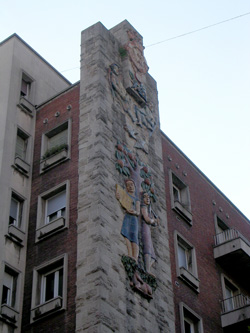
Check this building out!
It is on the way to Girona's historic center from the bus station. I know nothing about it, but it is festooned with these worker's paradise terra cotta image/forms. There are perhaps four times more of them than the number of jpegs that follow.

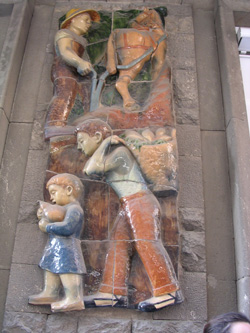
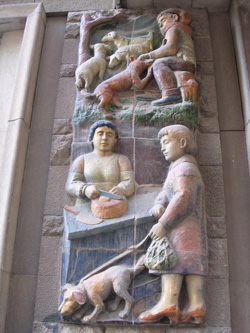
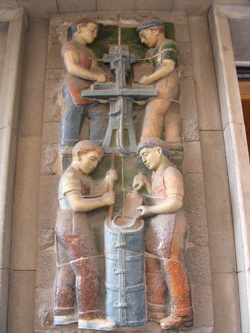
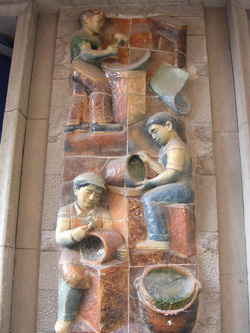
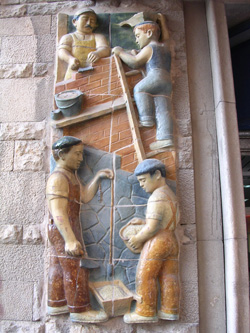
A tidy columnar stack, Mr. Bartender. It reminds me of Tom Otterness' stuff, where humanity resembles the hive... or a fairy tale.
The Call
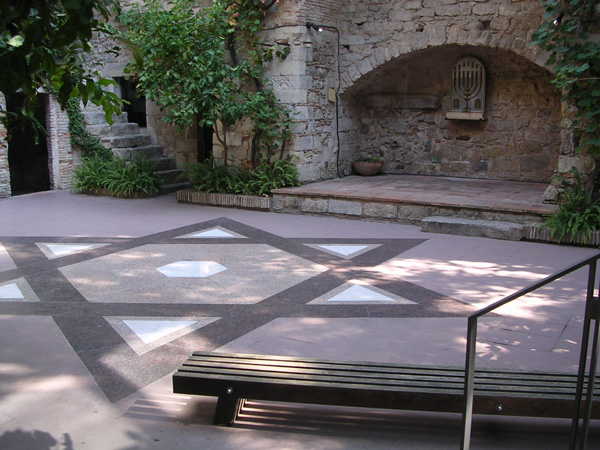
There's an ancient Jewish neighborhood in the center of Girona, called The Call. There are many many Calls in Catalunya. We are just beginning to figure it out. It's quite a labrynth.
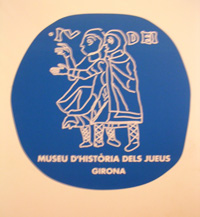
Here's some background via Google:
From before 890, when the Girona?s Jewish settlement is first mentioned, to 1492 when the last of the Jews were expelled from Spain, Girona embraced a lively and influential Jewish community that, at its height, exceeded a thousand people.?

As in other parts of Medieval Europe, the Jews of Girona enjoyed periods of peaceful coexistence with Christians alternating with times of persecution. Gradually, increasing anti-Semitism forced the Jews to retreat into the close confines of the Jewish Quarter. The Jews were required to seal the doors and windows that opened on to surrounding city?s streets until there was only one access into the call.? Then, in 1492, King Ferdinand expelled the Jews from Spanish Territory entirely. Only those who agreed to convert to Christianity were allowed to remain in the country.?

Before leaving Girona, the Jews were permitted to sell their properties and Christians were permitted to buy them. The new owners unblocked the Jewish quarter to give it free access into the city. They sealed over the properties left unsold along with the connecting lanes and courtyards. Over the centuries, the claimed area continued to build on top of itself, while the sealed areas slipped silently into the past where it remained, lost to memory, for 500 years.

Girona Museum of Art



Here's a result of a twitchy trigger finger as we tour the museum, here next door to Girona's cathedral.
The old stuff gets religious back in the day, the church was the only game in town. And since Jesus is a star player back then, that's why we see so much of him in a museum of ar of courset.
Still, the emphasis on the carnal isn't as terrific as it is elsewhere in Spain, so I've heard.
But this stuff is pretty hard assed:
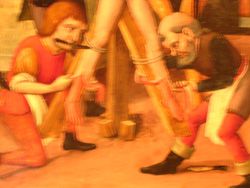
Saddam/Taliban style.
We were freaky too, back in the day.
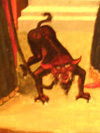
This will be too vivid:

...even though this image is blurred.
I read somewhere here on the web that movies of the terrorist beheadings are being transmitted and dowloaded on cell phones in London within twelve minutes of the deed.

Let's change the subject:

First of all, all door handles here look like this, although some are a little better made, some configurations change slightly, the differences are of a family.
All have the shell end that fits perfectly into the palm. Here the face plate bears Girona's symbol, some kind of dive bomber bird... at Tossa, the bird is sitting on the Torre.
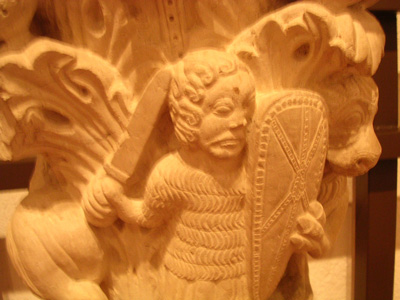
I noticed the glint on the tip of the sword, and I wondered if it was chiseled into the stone, or an accident of optics.
Girona
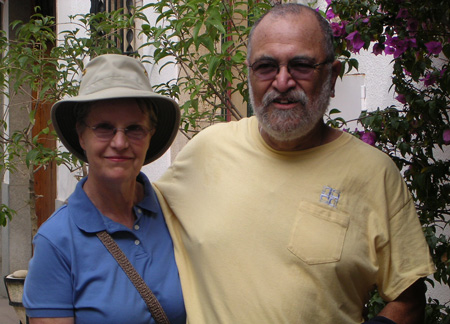
It was wonderful to have Gil and Daryl stay with us here. I worked for Gil when I was a kid architect (apprenticeship) and I consider him my mentor in that way. He restored historical buildings in California, and this means adobe structures. He has a grasp of the massing of earth and stone and of rough hewn wood. He grew up in the 70's 80's South San Fransisco Bay area, the area that became Silicon Valley. He was able to work out of the tilt-up clean industrial suburban language into his own soulful territory. I was lucky enough to have my hand in the drawings of Mission San Jose and the Presidio Chapel in Santa Barbara. Gil is a lot of fun to work for, and very demmanding in equal measure.
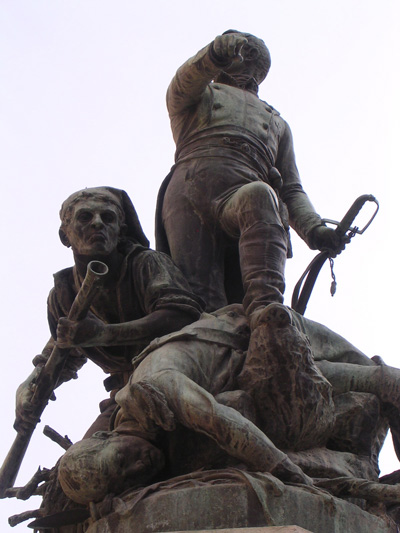
Tossa has a commuter bus to Girona that departs in the morning and returns twleve hours later. We knew we liked Girona but did we like it a whole half a day long?
The answer is yes of course. Girona is a beautiful city, nicely put together, a university in the historical center, clean industry is growing in the outskirts, small but large, great restaurants, cool people, and you can by a caganero sculpture too!
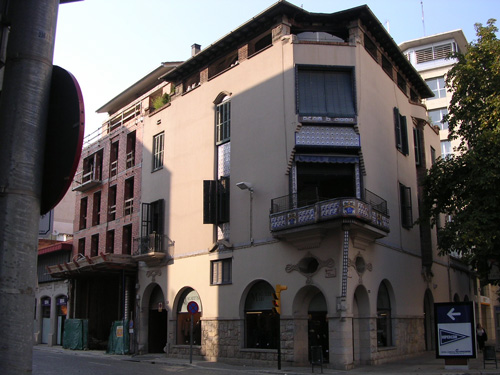
Check out how this building turns a corner. It's hard to see the faux rope decorative motif around the oval openings at the corner arches, freaky tile line from the bottom to the underside of the terrace that sits in the sliced corner, or that vertical window on the side that shoots up to a swollen parapet cum balcony.
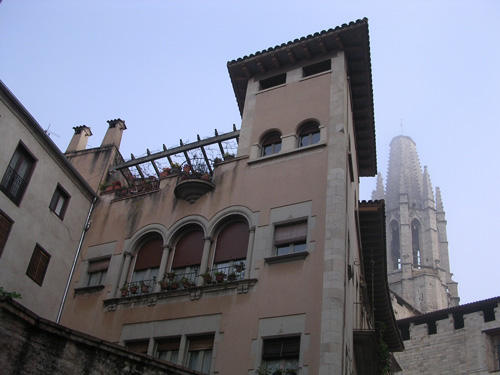
Here's a building that's all corners. You can approach this structure from below a flight of stairs that brings people from the riverside paseos to the historical and religious elevations of the city. The techtonics chatter from eaves to rafters to hand decorated tiles and on and on.
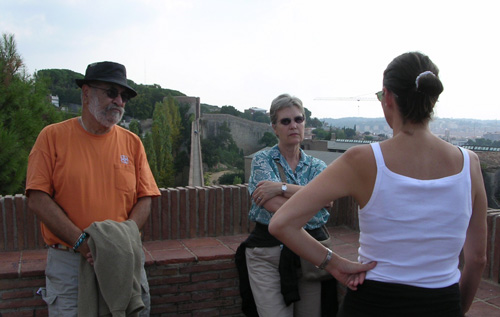
The old city is rimmedwith defensive walls that have been reknitted into a grand paseo that can take you from one end of the city to the other with views overlooking the city all the way. You can see it, the great wall of China kind of feature over Gil and Daryl's shoulders. The linear band of clearstories of the university can be seen to the right.
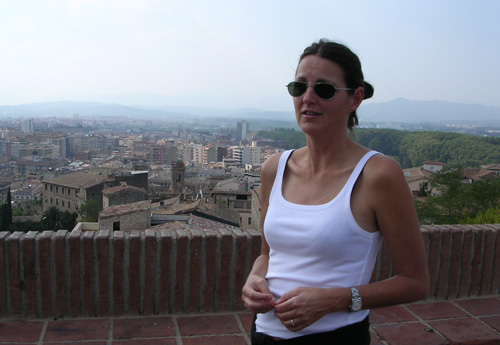
Here, you can see the other half of the panorama of Girona over Stephanie's shoulders. Note the lush green of the park beyond.
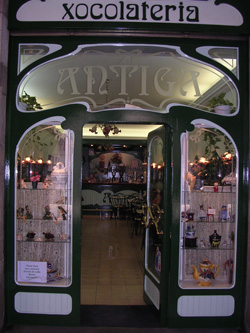
Let's have a bite of chocolate (ch=x in Catalan) before we go.
Fin del Verano
Our dear friends Gilbert and Daryl have been here and now they are gone. They went to Barcelona for the end of their travels and we begged off seeing Gaudi buildings with them, feeling a little guilty but also a little worried about juggling the "have-to-do's" that are piling up (art-wise and otherwise).
We wouldn't have been able to spend but an afternoon with them there anyway, since we have a dog (Juno) who is house bound when we travel. The bad news is that Juno is beginning to show signs of her terminal illness, she was diagnosed a year ago by a vet in Dallas, whose diagnosis gave her six months to live. So since then, we've been cherishing every day with her, spoiling her a little, calling her the perra milagra (miracle dog), hoping that the last days won't be horrible. This is our second dog who has had cancer (Index, our first male Beauceron had lymphoma and passed when he was five years old). Unlike lymphoma, mast cell tumors won't sieze vital systems and shut you down, it will just spread like weeds in the garden. Well, enough of this here. Right now, Juno is still ok by and large. Today.
And the weather has been incredible for the past few weeks. People here have said that September October are the best months in Catalunya and this is exactly correct. There have been several exceptional moments sitting in the dappled sun with a sweet wind that is fresh and not yet cold, the nights still warm with a clear sky splashed with stars. We are still wearing the summer shorts, but the time is coming to break out the boxes of winter clothes. Our nieghbors are keen to tell us that this is the last time to jump in the water as they do themselves. Bear in mind that they are all elderly, mayoras (ladies). One is nearly eighty, and they like the Autumn water. They say it's dulce but I still feel too much like a wussie to jump in. I claim that I've been scarred by the chilly Pacific waters of SoCal.
Winky Emoticon! ;-)
This morning as I walked Juno back from the beach for her morning excretions, I bumped into Kiko at Bar Josep and he bought me a cortado. He was in shorts but wearing a light jacket. He invited us to go with him to a festival next week called San Grau, where the townspeople gather on a local hilltop and party all night, bonfires, cooking paella and dancing sardanas, I imagine. Kiko says we will sleep in a tent or in a car overnight... and while he is planning to do this for one night, some people carry on for the week. Party people! We shall see what this is all about soon.
And this morning after our last guests depart, marks the beginning of the seriously immersive phase of living here in Spain. For the next five or six months, we will be alone together, Stephanie and I... and us with this town. We have just had the first delivery of firewood (lenya) to the house (66 Euros for what looks like a quarter of a cord). We will be thinking about keeping the warmth inside the house. This is a three hundred year old stone house that sits atop a shallow water table by the sea with walls that have a tendency to wick the moisture up into it by capillary action, no central heating and the only heat sources are a fireplace, three electric heaters and a couple of butano (gas) heaters that have reputation of increasing the humidity so much inside that the windows condensate puddles of water. I try to ease our anticipations by bearing in mind that this place has the history and reputation of being the first bar in Tossa and a place where the fishermen would hang out at the end of a day, roasting their sardines in the fireplace as they sip their wine. I hope this famed fraternal glow is an intrinsic quality that we can recapture in the coming colder months.
So with all this, an intro to a few pictures gathered from Gil and Daryl's visit that will follow in the next few posts.